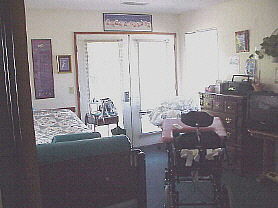Articles
People First of Oregon
Fairview: The Closing Chapter
![]()
Articles
California takes a look at how Oregon cares for
its developmentally disabled citizensIs California ready to place its medically fragile
and forensic clients out into the community?Over the last few months, CAPT has joined DDS staff and others in traveling to New York, Pennsylvania, Minnesota and Oregon to see how other states care for their developmentally disabled citizens.
This fact-finding mission grew out of a December meeting of the Advisory Committee on Restructuring DC Services, composed of top DDS leaders, other state officials, and various "stakeholders" involved with developmental disabilities. CAPT was the only union there, represented by State President Linda Pinkerton and two CAPT consultants.
At the meeting, DDS told the committee the cost of needed improvements for the DCs would span 10 years and cost nearly $1 billion. As a result, some committee members suggested the need for smaller state-owned, state-operated facilities.
As the representative for CAPT, I joined a small group of stakeholders and DDS staff in visiting Oregon's care system.
Based in Salem, officials from the Oregon Department of Human Resources provided an extensive overview of its system and set up visits to its state-operated homes in several communities.
Oregon's institution for the developmentally disabled, Fairview Training Center, is set to close its doors next year. In the mid '80s Fairview came under fire from the federal government around civil rights issues and care. Fairview consumes about 30 percent of Oregon's DD budget and serves about 3 percent of the population in need. In 1996, the average cost per client at Fairview reached $190,000.
Fairview Training Center
Unlike California, which has an entitlement system, almost half of the 3,500 Oregonians in need receive no services. That's because DD programs don't have sufficient funds to provide the needed services and rates paid to community service-providers are too low.
For these reasons, Oregon initiated a long-range plan to move clients from Fairview into the community and reinvest a significant portion of its budget in areas of high need.
By May 2000, the plan is that all Fairview residents will be moved into the community and receive quality services at a more reasonable cost.
Wages paid to direct care staff employed by community providers would increase to resolve some of the stability issues. And about half of the 3,500 adults on the community waiting list would begin to get services.
Since 1990, about 100 have moved into the State-Operated Community Program. Of the 143 remaining at Fairview, about 74 will be moving to SOCP.
Some of the new Oregon facilities provide a
duplex atmosphere, with home for two clients
on one side and three on the other.During our visit, we focused on SOCP homes -- two for forensic, four for behavior and two for the medically fragile. With the exception of the forensic homes which were on the unguarded grounds of the Eastern Oregon Mental Hospital, all the homes we saw were fairly new and in community settings.

All homes were specifically built for the needs of their residents. Halls were widened for wheelchair and bed access. Kitchens were open for easy access. Some homes had open courtyards in the center of the facility for privacy and yet provide an outdoor quality. All had large yards and adequate parking off the street to avoid neighborhood complaints.
The homes have special equipment for the medically fragile, all clients have their own rooms and doors give easy access for non-ambulaty access.
The behavioral homes were "hardened" with walls that can withstand being hit. Each home provided individual bedrooms for residents and the medical homes had outside doors on each room to allow easy access for non-ambulatory clients.
Each SOCP home has no more than five clients and staff-to-client ratio is one-to-one or one-to-two. Oregon building codes and laws see five people as a single family dwelling. Six or more would require special fire codes and residential occupancy hearings.
Surprisingly, I was impressed with the homes and the way the clients were treated. I had heard about and seen some truly appalling community facilities in California's system, so I was not expecting to see the attention to detail and quality of care I encountered in Oregon's state-operated system.
Despite the positive impressions, it is important to stress that California is a completely different animal with greater needs and demands. I left with some concerns that I believe should be addressed before California even considers a total move away from our developmental centers and toward a state-operated system such as Oregon's. Just a few of these concerns are:
Oregon's new state-operated homes have special baths and lifts for the medically fragile
Scale of operation
After Fairview's closure in 2000, Oregon's SOCP will have approximately 174 clients in 30 to 40 homes. The cost to build each home runs from $200,000, excluding the land. California currently houses 3,900 clients in its five developmental centers. Can we provide appropriate housing and care for all these individuals in such a state-operated system?

Healthcare workers
One of my biggest concerns is the lack of licensed staff in Oregon's homes, with the exception of the homes of the medically fragile where one RN or LVN staffs the home around the clock.
The commonly used healthcare worker in Oregon's SOCPs are Habilitation Tech 2s.
Open, spacious kitchens
provide wheelchair access
and an enhanced number of
healthcare workers.These are non-licensed caregivers whose only requirements are that they be 18 years of age, pass a criminal history and drug test, and complete a core competency training that requires up to 80 hours of training for new staff, less for experienced.
Because the homes are fairly new and clients are prior residents of Fairview, the vast majority of caregivers are long-time Fairview employees -- some with 10 to 20 years of experience with developmentally disabled individuals. As new caregivers are hired off the street to fill new or vacated jobs, I wonder if the quality of care will remain as high?
Staffing ratios
Throughout the SOCP, the staffing ratios are one caregiver to one or two clients. Could California afford high-quality licensed care at such enriched staffing ratios?
Medical and dental care
As Oregon has a managed care system, clients who leave Fairview are given two to five health plan choices. Before a client leaves, a plan has been chosen with a primary physician, dentist and specialists determined. In addition, the department has a physician on staff to consult and train other physicians on caring for the developmentally disabled.
Currently one of California's biggest problems in community care is the lack of medical and dental care. Unless care plans can be established for our clients, placement of California's more profoundly retarded and medically fragile should not move forward.
Forensics
Oregon's SOCP provides housing for its sexual offenders who are developmentally disabled. Currently our state is having difficulty getting southern California communities to accept the placement of 75 forensic clients in a fenced, high-security area of Lanterman Developmental Center. Given this climate, I find it difficult to believe communities would accept placement of these individuals in neighborhood settings or on the open grounds of state land.
Home visits
Visits by family and friends are encouraged and Oregon SOCP homes are open at any time to visitors. In many California homes, visits are discouraged and in some cases homes are locked and not available during certain hours.
There are several other issues that need to be discussed before any decisions are made. DDS is hoping to bring together those who visited New York, Pennsylvania, Minnesota and Oregon. The plan is to come up with some proposals for the full advisory committee.
CAPT President Linda Pinkerton visited the DD systems in New York, Pennsylvania and Minnesota, and her report will be printed in an upcoming issue. Outreach will keep readers informed as new information becomes available.
This article by Carol Wiesmann, Managing Editor was published in the May 1999 CAPT (California Association of Psychiatric Technicians) Outreach magazine
Photos courtesy of DDS